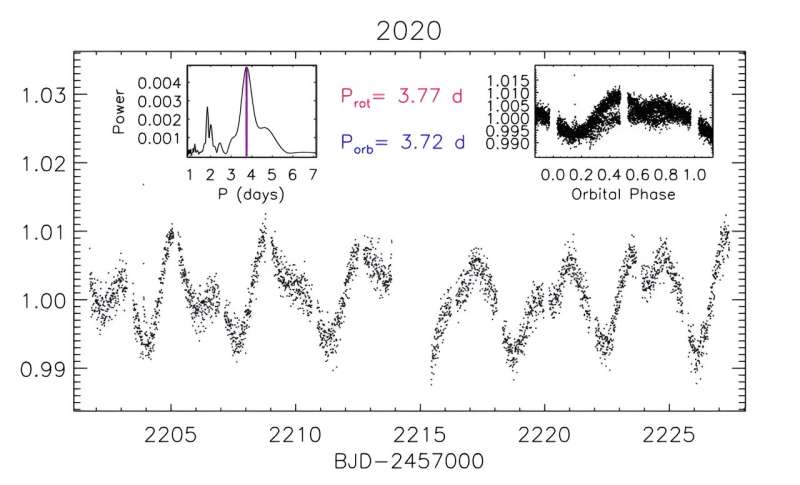TESS light curve of TIC 43152097 in 2020. Credit: Frasca et al, 2023
Using NASA's Transiting Exoplanet Survey Satellite (TESS), European astronomers have discovered an eclipsing binary in the open cluster NGC 2232. The binary, designated TIC 43152097, is the first such system detected in this cluster. The finding is reported in a paper published July 26 on the preprint server arXiv.
Eclipsing binaries (EBs) are systems consisting of two stars that orbit each other in a plane along our line of sight. Therefore, the two components eclipse and transit one another, which is seen in the light curves of these systems as periods of practically constant light, with periodic drops in intensity.
Now, a team of astronomers led by Antonio Frasca of the Catania Observatory in Italy, reports the detection of the first EB in NGC 2232—a young and bright open cluster located some 10,600 light years away from the Earth. The discovery is a result of TESS observations conducted between December 2018 and January 2021. The finding was confirmed by follow-up spectroscopic observations using High Accuracy Radial velocity Planet Searcher North (HARPS-N) spectrograph.
"We have reported the discovery and follow-up study of the eclipsing binary system, TIC 43152097, which is composed of low-mass stars in a well-detached configuration and belongs to the young open cluster NGC 2232," the researchers wrote in the paper.
The observations found that TIC 43152097 is composed of a late F-type dwarf primary star and a late K-type pre-main sequence (PMS) secondary star. The orbital period of the system was measured to be approximately 3.72 days.
The results suggest that the primary star of TIC 43152097 is about 12% larger and 16 more massive than the sun. The secondary component has a radius of 0.88 solar radii and its mass is estimated to be 0.76 solar masses. The effective temperatures of the primary and secondary stars were found to be 6,070 K and 4,130 K, respectively.
The study also found that the lithium abundance of the primary and secondary component is at a level of 2.95 and 1.97, respectively. The astronomers explained that such different results for the two stars of one system follows the general trend of lithium depletion as a function of effective temperature displayed by clusters of similar age to NGC 2232.
Summing up the results, the authors of the paper noted that the secondary star of the system turns out to be about 7–11% larger than predicted by standard evolutionary models.
"This result indicates that radius inflation of the order of 7–11% is already occurring in late K-type stars at ages considerably earlier than the ZAMS [zero-age main sequence], when these objects are still in the PMS evolutionary phase," the researchers concluded.
More information: A. Frasca et al, TIC 43152097. The first eclipsing binary in NGC 2232, arXiv (2023). DOI: 10.48550/arxiv.2307.14081
Journal information: arXiv
© 2023 Science X Network
























